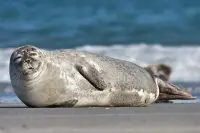Harbor seal (Phoca vitulina) is one of the true seals. It is distributed across the Northern Hemisphere. It has round-shaped head and short flippers. The coat of harbor seals has gray to silvery-white in color. Its nostrils are uniquely shaped as ‘V’. It has spotted skin and there is a pattern of dark spots over pale silver background. The spots are gray to blackish-brown in color. There are five subspecies of harbor seal.
It can grow up to a length of 6.1 feet and weighs up to 290 pounds.
A female harbor seal has a lifespan of 30 to 35 years while males can live up to 20 to 25 years.
Mating season occur underwater and female bear single pup in a year. On average, a female harbor seal matures at the age of 3.72 years. In California, mating occurs between March and May
A mother seal weans her pup a fter 3 to 4 weeks. At birth, the pup weighs 35 pounds and gets double in weight at the time of weaning.
fter 3 to 4 weeks. At birth, the pup weighs 35 pounds and gets double in weight at the time of weaning.
Harbor or common seals are the most widely distributed seals. They are found along the coasts of North Sea and the Baltic Sea; as well as the North Pacific and North Atlantic oceans. In the Atlantic, they are found from Maine to Massachusetts. In California, harbor seals are present along the shorelines of Pacific.
The habitat of harbor seals is the usual resting sites like sandy shorelines and rocky coasts. They are found in estuaries and off the coasts of New England to prey on fish.
The diet of harbor seals consists mainly of fish including herring, flatfish, merling, mackerel, mossbunker, salmon, white weakfish and anchovy. Besides, they also rarely eat squid, crabs, shrimp and mollusks.
Other Name: Common seal





